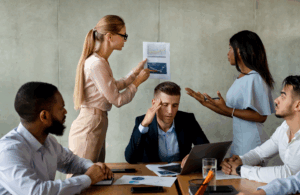
How to Design and Build a High-Impact BEx Team

High-performing organizations understand that achieving lasting value and continuous improvement starts with the strength of their Business Excellence, or BEx, teams. Creating a BEx team involves dedication and thoughtful structuring through training programs and effective motivational strategies. It’s one thing to bring a group of your best employees together. It’s another altogether to create a cohesive team that can achieve business excellence. In this blog we’ll explore the essential elements of designing and building a BEx team that delivers sustainable results, emphasizing team structure, training, and motivation.
Structuring a BEx Team for Success
The foundation of any business excellence initiative is the team that runs the project. To achieve maximum effectiveness, a team must be tailored to the organization’s unique goals, culture, and operational landscape.
Start by identifying the key roles needed for the project. While the exact configuration will vary, a typical BEx team often includes:
- Team leads responsible for driving projects, maintaining alignment with KPIs and organizational goals, and serving as a primary link between the team and senior leadership.
- Analysts who collect, manage, and interpret data to uncover actionable insights that guide improvement initiatives.
- Change agents tasked with fostering collaboration, facilitating communication, and ensuring the adoption of new practices across departments.
- BEx specialists who bring expertise in methodologies like Lean Six Sigma, providing guidance along the way, and ensuring data-driven decision-making and process optimization. Get in touch with Adonis Partners to find out how we can be your BEx specialists.
As you read through this list, certain members of your organization may come to mind. Keep them in mind when you build your business excellence team. Hand-selecting the right employees for each role will allow the team as a whole to flourish.
An autonomous structure is critical for maintaining momentum. Team members will be empowered with decision-making authority, enabling them to put their strengths into driving change. To keep the balance of the team, instill clear accountability measures such as regular reporting to leadership and steps to keep projects on track to meet broader business objectives.
Another factor to take into account is cross-functional representation. Selecting members from only one department of the organization will limit the diversity of the team. With a wide range of staff, there will be a more comprehensive understanding of processes, reduced silos, and an enhanced ability to implement improvements that resonate across the organization.
Training: Building a Skilled and Agile Team
Once the structure is established, the next priority is equipping the team with the skills and knowledge necessary to execute BEx initiatives effectively. Merely giving your employees titles and sending them off with a project is a weak structure, lacking set guidelines and principles. But training itself isn’t a one-size-fits-all endeavor; it has to be tailored to each role and career development path.
This is where your business excellence specialists come in. They’ll begin with the core training on Lean Six Sigma methodologies, focusing on the tools and techniques most relevant to the organization’s objectives. Certifications, like Green, Yellow, and Black Belt, not only strengthen credibility but set up the team for success with technical training in addressing complex challenges.
Equally important are the soft skills that are part of Lean Six Sigma:
- Communication and influence: Crucial for gaining buy-in from stakeholders and leading cross-departmental initiatives.
- Proactive problem-solving: Encourages innovative approaches to tackling inefficiencies and streamlining processes.
- Change management: Helps team members guide the organization through transitions smoothly and effectively.
Workshops, seminars, and access to digital learning platforms will reinforce Lean Six Sigma and keep staff up to date on industry trends and news. Pairing less experienced members with seasoned mentors will foster a culture of continuous learning while fueling the group’s commitment to the project’s goals.
By investing in robust training programs, organizations increase the immediate effectiveness of their team while positioning them as key drivers of long-term growth and innovation.
Motivation: Rewarding Success to Sustain Momentum
Even the most skilled and well-structured team cannot thrive without motivation. Keeping a BEx team energized and committed to continuous improvement requires a deliberate focus on rewards and recognition.
Start with clear goals that are both ambitious and achievable. Teams are more motivated when they understand how their work contributes to the organization’s overall success, but not when goals seem unattainable. Use metrics and dashboards to track progress, establishing milestones along the way.
Recognition doesn’t always have to be monetary. While financial incentives such as bonuses and salary increases are important, non-financial rewards often significantly impact morale. Examples include:
- Public Recognition: Highlighting team achievements during company meetings or in newsletters can boost team pride and demonstrate organizational support.
- Professional Development Opportunities: Offering access to conferences, certifications, or advanced training shows a commitment to individual growth.
- Personalized Rewards: Tailoring recognition to individual preferences—whether it’s a day off, a meaningful gift, or a simple thank-you—can make the recognition feel more impactful.
Developing a workplace where appreciation is prevalent includes providing constructive feedback and valuing all contributions from the team. Open communication channels allow team members to share their challenges and successes, furthering trust and collaboration.
Designing and building a high-impact BEx team is both an art and a science. From structuring the team for autonomy and cross-functional collaboration to providing tailored training and fostering motivation through recognition, every element plays a vital role in driving continuous improvement.
By investing in the right people, equipping them with the tools and skills to succeed, and nurturing a culture of appreciation, organizations can unlock the full potential of Business Excellence. Ready to transform your approach to operational excellence? Let’s discuss how we can help you build a team that delivers measurable impact and growth.

